 Employee Experience Best Practices
Employee Experience Best Practices
Don’t be one of the companies that delivers a boring, unmotivated, unexciting onboarding experience. We share how to ensure onboarding success.
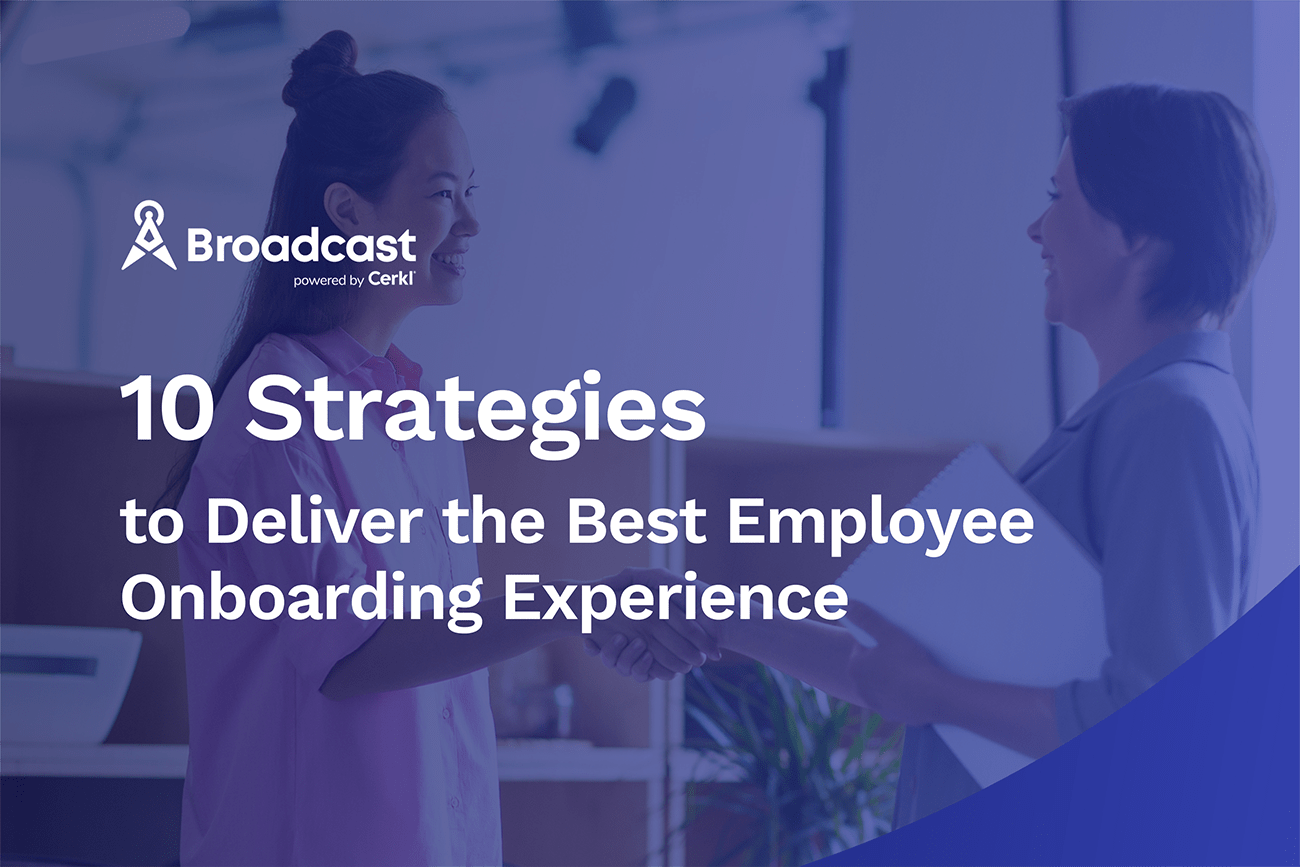
.png)
Strategy is an important component of internal communications. Ensure you’re communicating through the right channels at the right frequency with our Internal Communications Channel Audit worksheet.
Access NowEmployee onboarding experiences can pre-define expectations and perceptions of the employee experience (EX) before it's even begun. While embarking on a new job can be filled with anticipation and optimism, inadequate onboarding can leave enthusiastic employees feeling perplexed, let down, and disappointed. But when new employees have a good experience, they’re more likely to connect with the organization and embrace company culture. This leads to enthusiasm, commitment, and desire to be productive.
According to a 2022 Paychex survey, 70% of employees believe that the onboarding process can “make or break a new hire’s experience.” Despite this, it found that only 52% of employees who complete onboarding programs are satisfied with the experience. The responses leave a lot to be desired. For instance, only 32% said they found them exciting, 31% found them engaging, and 24% found them boring.
The chart below shows the Paychex results with graphic clarity.
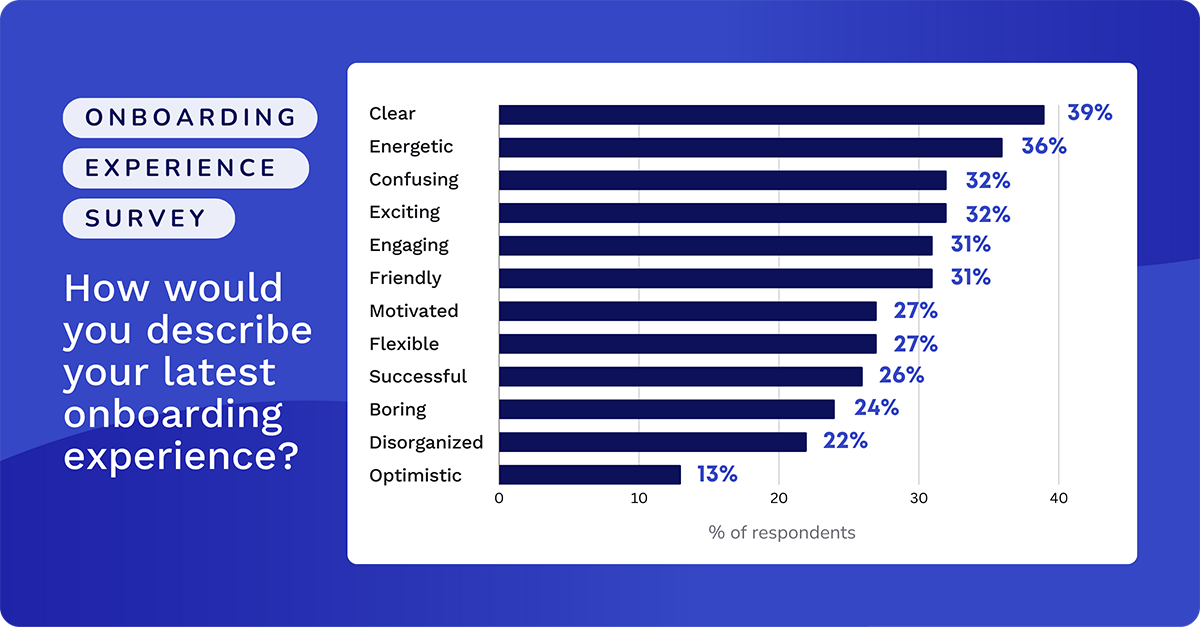
Additionally, 56% felt disorientated, 52% felt let down, and 46% simply lost interest.
So, how can companies create a seamless onboarding experience for their employees that aligns with their organizational culture and sets them up for success?
Despite the current economic climate, unemployment rates in the US are still at historic lows, and following layoffs at tech companies, the labor market is still tight. This means companies should get rid of complicated, unattractive, and costly hiring and onboarding processes.
We’re going to explore the significance of the employee experience, define the concept of employee onboarding, and present 10 strategies for enhancing the onboarding process. We will highlight the potential benefits that a well-structured onboarding program offers both employees and employers, supported by examples of good and bad onboarding experiences. Replicating these best practices will help you achieve a higher return on investment (ROI) from your onboarding process and elevate your employee experience.
Employee experience is crucial for a prosperous business environment. It reflects how employees perceive their jobs and their interactions with the company. This extends from training and development and the work environment to the relationship with colleagues and managers.
The Paychex survey found that 52% feel inadequately trained, and blame this on a poor onboarding process. The stats are even higher for employees in small companies (66%) and those working remotely (63%). Another hugely negative impact is that when onboarding doesn’t meet the expectations of new hires, it directly affects turnover. Asked if onboarding had influenced their plan to leave their employer, 50% said yes, only 20% said no, and an uncertain 28% said maybe.
The importance of employee experience is reflected in three key areas: productivity, talent attraction, and employee retention.
Understanding the importance of employee experience paves the way to an exploration of the concept of employee onboarding and how it contributes to overall employee experience.
Upgrade your company’s internal comms to enhance employee communication
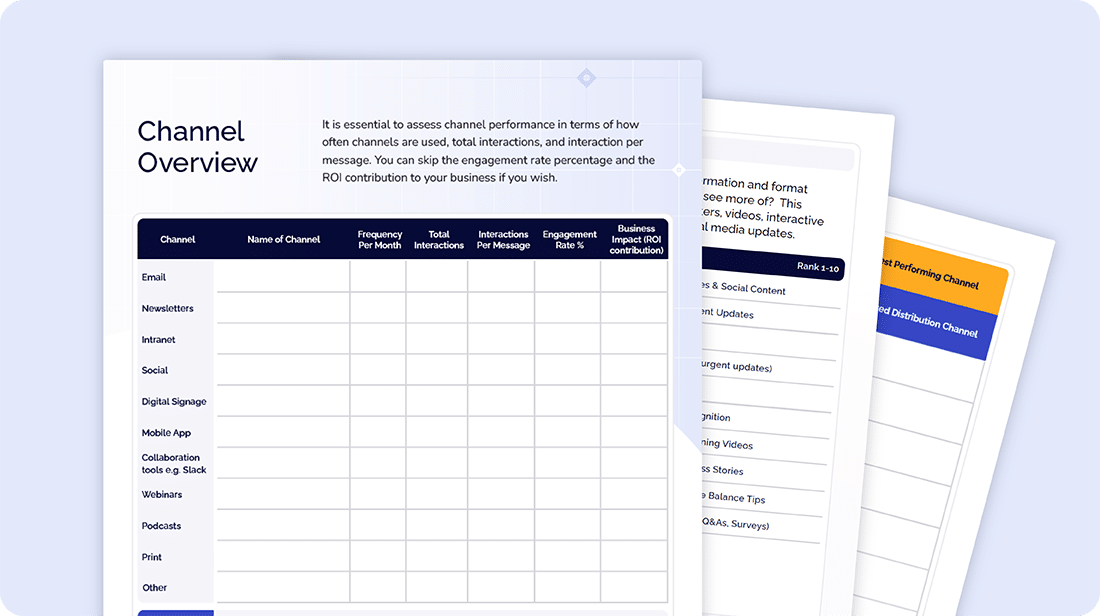
Employee onboarding indicates the process of integrating a new employee (or hire) into an organization. It comprises a series of activities that a new employee engages in after being hired into a company. The aim is to acquaint new hires with the company's culture, values, objectives, and mission, ensuring that they are equipped with the necessary skills to excel in their respective roles.
BambooHR surveyed employees to find out more about their onboarding experiences. They found that those who had a positive onboarding experience were three times more likely to be engaged and remain in the company. More than 80% of employees who had a positive experience continue to hold their organizations in high regard.
It starts as soon as a new employee signs a work contract — and extends through their first few weeks or months on the job. It's a transitional phase where the new hire moves from being an outsider to becoming an integral part of the team. It encapsulates the initial education, training, and socialization needed to hit the ground running.
Onboarding is not the same as orientation, which is a part of the onboarding process. Orientation involves signing paperwork, reviewing company policies, enrolling in benefits, and so on. Onboarding is an ongoing process that helps employees acclimate to the organization and master their roles.
So, it stands to reason that investing in a comprehensive onboarding program signifies the first step in creating a positive employee experience. The onboarding experience sets the tone for an employee's journey within the organization and leaves a lasting impression on them. Therefore, it's vital to ensure this process is effective, engaging, and represents the company culture accurately.
For a successful onboarding process, businesses often follow a structured approach known as the 5Cs of onboarding.
The 5Cs of onboarding experiences are a set of guidelines that companies can follow to create an effective onboarding program. They commonly comprise compliance, clarification, culture, connection, and checkback.
The 5Cs are not merely a checklist but a tool that, when used correctly, can yield highly successful onboarding that contributes effectively to a strong employee experience.
A successful employee onboarding experience can profoundly affect not only new recruits but also the companies they are joining. With this in mind, we’re going to break down the benefits of a good employee experience as it applies to both employees and employers.
The onboarding experience directly influences an employee's initial perception of their workplace. It establishes their comfort level, clarifies aspects of their assigned role, and enhances their understanding of the company's vision and culture.
A well-planned onboarding process also has considerable advantages for organizations.
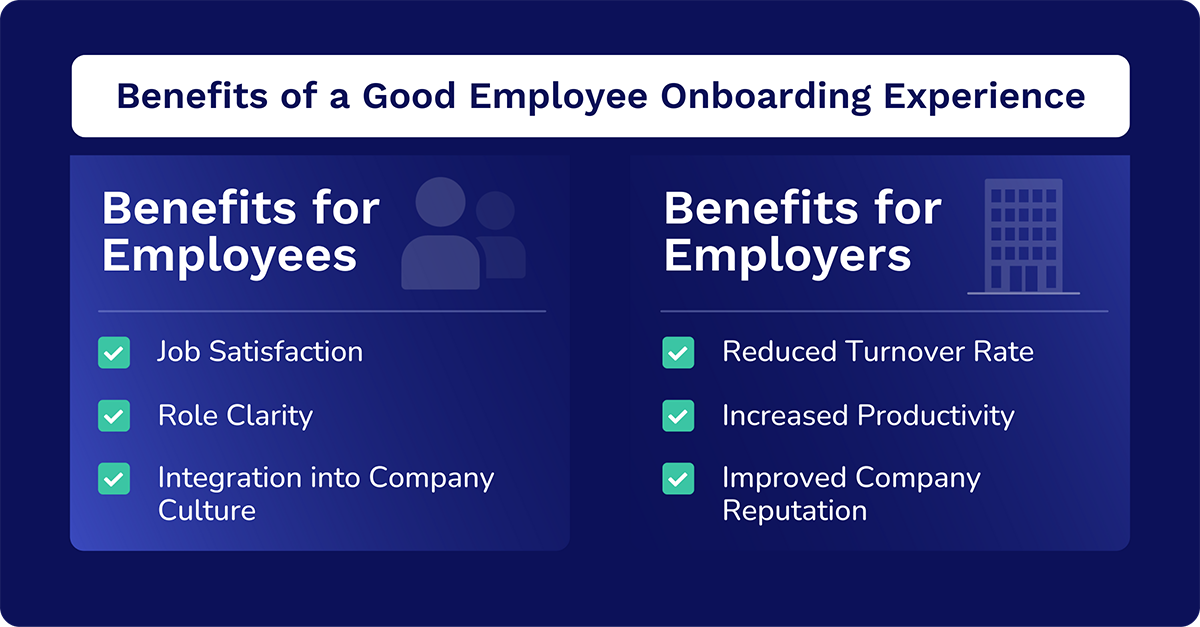
The ROI of a successful onboarding process is high. A well-run, effective onboarding program is an investment that can yield substantial returns over the long term. Successful onboarding can reduce the time to productivity for a new hire, impacting the bottom line positively. The recruitment costs, including advertising, screening, interviewing, and hiring, are investment costs that have a much better return when an employee stays with the company longer.
SHRM indicates that the total cost of losing an employee can amount to tens of thousands of dollars. Therefore, retaining employees through effective onboarding directly impacts the company's financial health.
In a SHRM article, The Real Costs of Recruitment, Katie Navarra quotes their benchmarking data that found the average cost of just one hire was close to $4,700. She also quotes Edie Goldberg, founder of the Menlo Park, California-based talent management and development company E.L. Goldberg & Associates, who says it can cost three to four times an employee's annual salary. “That means if you're hiring for a job that pays $60,000, you may spend $180,000 or more to fill that role.”
Furthermore, it’s not just productivity that is affected. There are also non-sustainable emotional tolls that hiring teams face, she says.
Upgrade your company’s internal comms to enhance employee communication

Having examined why a good onboarding experience is critical, it's time to explore 10 strategies that can help create a robust onboarding process.
Sending materials relating to company policies, culture, and role expectations before an employee's first day can help them arrive prepared.
A warm welcome goes a long way. The Tech-Enabled Employee Experience 2022 Culture Report from Achievers Workforce Institute states that being warmly welcomed is the #1 way to help employees experience an even deeper sense of belonging. Arrange a tour, introduce team members, or have a welcome lunch to make the new hire feel special.
“Being warmly welcomed may seem like the simplest of the belonging pillars, but AWI’s research shows it is often the most overlooked.”
Provide clear, organized training modules to help new employees understand their roles better and reduce confusion.
Assigning a 'buddy' helps new hires assimilate into the company culture faster. This can also promote relationship-building.
Microsoft piloted a buddy program involving 600 employees across the organization to evaluate results on productivity and engagement. These showed that 56% of new hires who met with their onboarding buddy at least once in their first 90 days said their new contact helped them to quickly become productive. That percentage jumped to 73% for those who met two to three times with their buddy, 86% for those who spoke four to eight times, and 97% for those meeting more than eight times.
“Every new employee should have an onboarding buddy,” says Priya Priyadarshini, general manager for employee career and development at Microsoft.
Onboarding software can help facilitate role clarity and increase productivity by tracking progress, giving reminders, and providing resources.
Regularly checking in with new employees can make them feel valued and assist in addressing any issues or concerns they might have early on.
Open channels of communication encourage interaction and allow employees to voice concerns or ask questions.
Setting achievable short-term and long-term goals can help new employees understand their roles better and achieve success faster.
Recognizing and rewarding initial achievements can boost employee morale and foster a sense of accomplishment.
Constructive feedback is crucial in the early stages of employment as it enables new hires to learn, grow, and adapt to their roles more efficiently.
Implementing these strategies can help create a conducive experience that effectively welcomes new employees while adequately preparing them for their roles. And if you miss the boat, Paychex suggests re-onboarding.

Re-onboarding isn’t only for new hires, it’s a concept that enables employees to start a brand new introductory process for existing employees. It’s the ideal way that you can reestablish and communicate cultural expectations in the workplace.
According to the Paychex survey, the top benefits are:
One of the most effective methods for understanding how to enhance your employees' onboarding experience is examining real-life employee experience examples of what works and what doesn't work. Making a good first impression is crucial to fostering employee engagement and reducing turnover rates, but a mishandled onboarding program has the potential to instill negative sentiments among employees from the get-go.
Let’s look at some of the best practices that can transform an ordinary onboarding process into a remarkable employee onboarding experience.
By comparison, a poorly executed onboarding program can be detrimental to employee morale and motivation. Here are a few examples of bad experiences.
Having looked at good and bad practices, understanding how to measure the success of your onboarding experience is the next essential. Here is a very simple step-by-step guide:

Implementing these steps will help you gauge the effectiveness of your employee onboarding checklist and overall program. Remember, the key to success lies in continuously refining your approach based on feedback and changing industry standards.
Cerkl Broadcast is a versatile platform that will help you to facilitate and measure your employee’s onboarding experiences. It enables open channels of communication via its omnichannel capabilities and provides opportunities for valuable surveys and feedback.
Broadcast's feedback and analytics tools allow communicators to measure message impact. This improves and adds efficiency to the planning process with data-driven insights that enable team leaders to effectively adapt and improve strategies.
Successful onboarding strategies rely on good, solid internal communication programs. How good is yours? You can find out by doing a simple internal communications audit with our help. It’s free, and you can access our audit template here. Then you can reach out to us and we can help you improve your existing program or structure a new one.
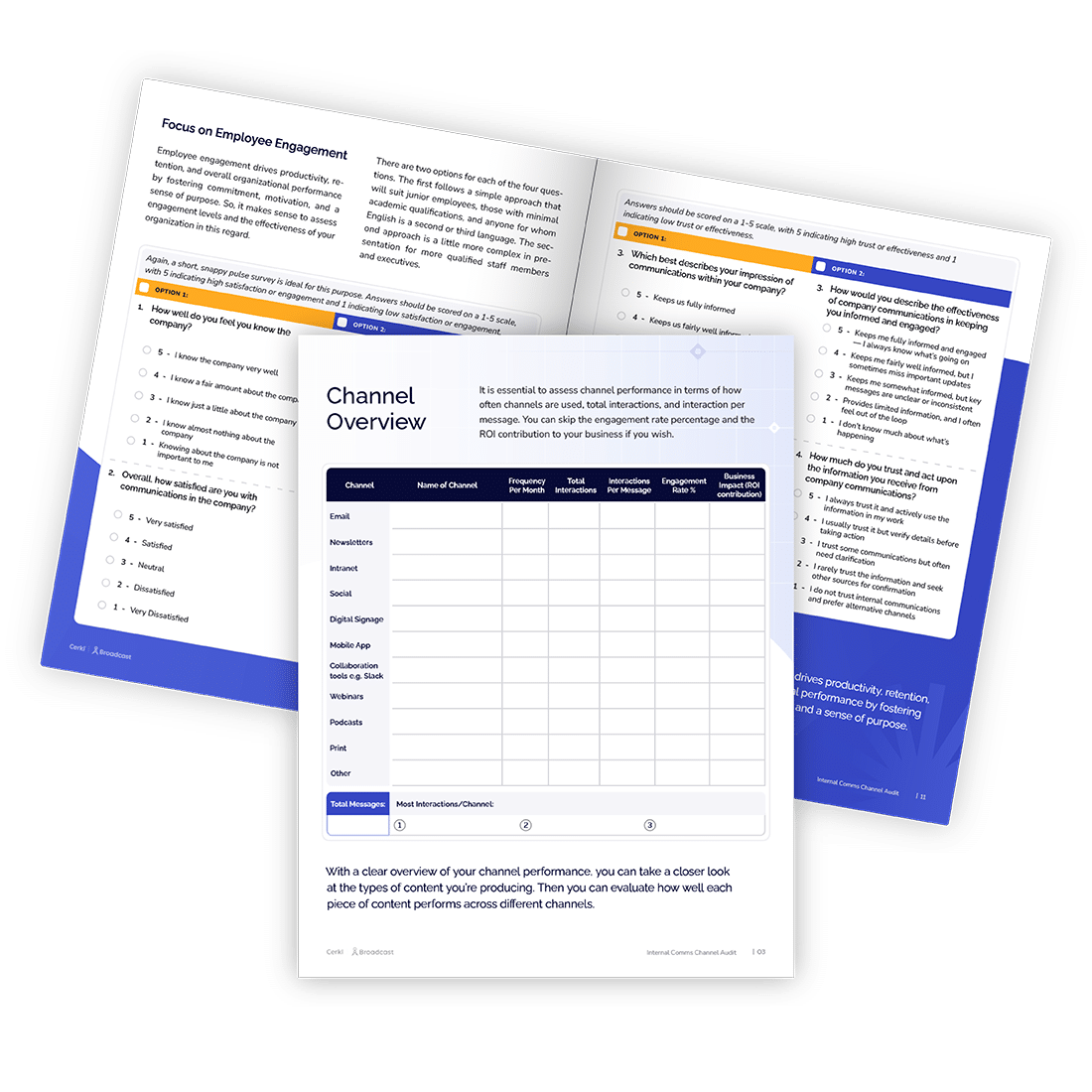
Upgrade your company’s internal comms to enhance employee communication
What is the employee onboarding experience? This is the process used to integrate new hires into a company. It encompasses orientation, training, and assimilation into the company’s organizational culture.
What are the 5 Cs of employee onboarding? Compliance, clarification, culture, connection, and checkback are usually listed as the 5 Cs of employee onboarding. Organizations use them to introduce legal and regulatory aspects, define roles and expectations, communicate values and mission, build relationships within the organization, and provide ongoing support and feedback.
How to create a great onboarding experience? You need a comprehensive approach that includes clear communication, and proper training, effective socialization, and involves fostering a sense of belonging to the organization.
How can you make onboarding more engaging for new hires? To make onboarding more engaging for new hires, incorporate interactive elements such as team-building activities, mentorship programs, multimedia resources, and opportunities for open communication to enhance their involvement and connection with the company.

Upgrade your company’s internal comms to enhance employee communication